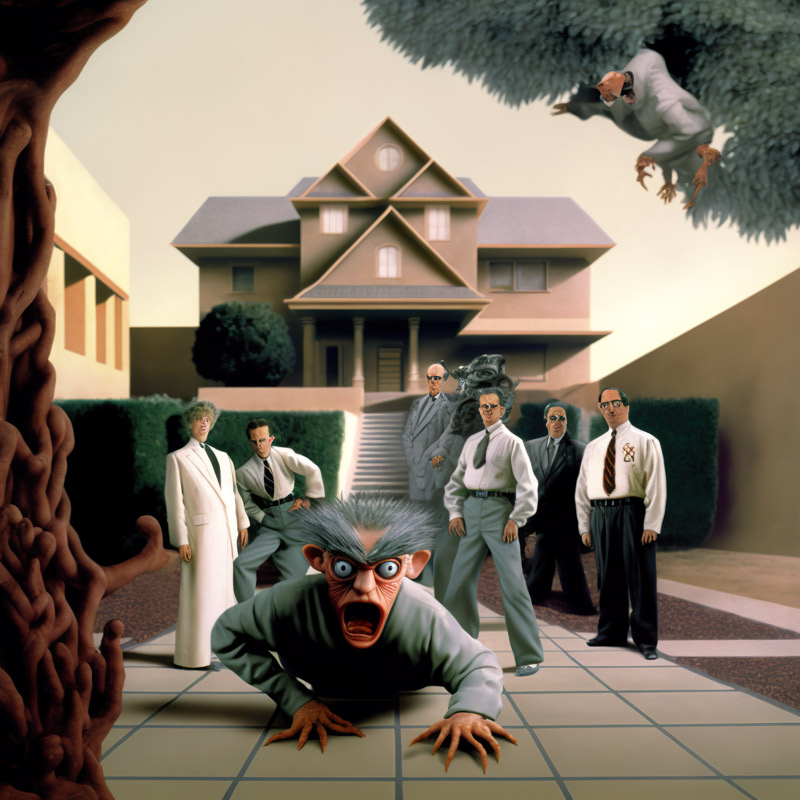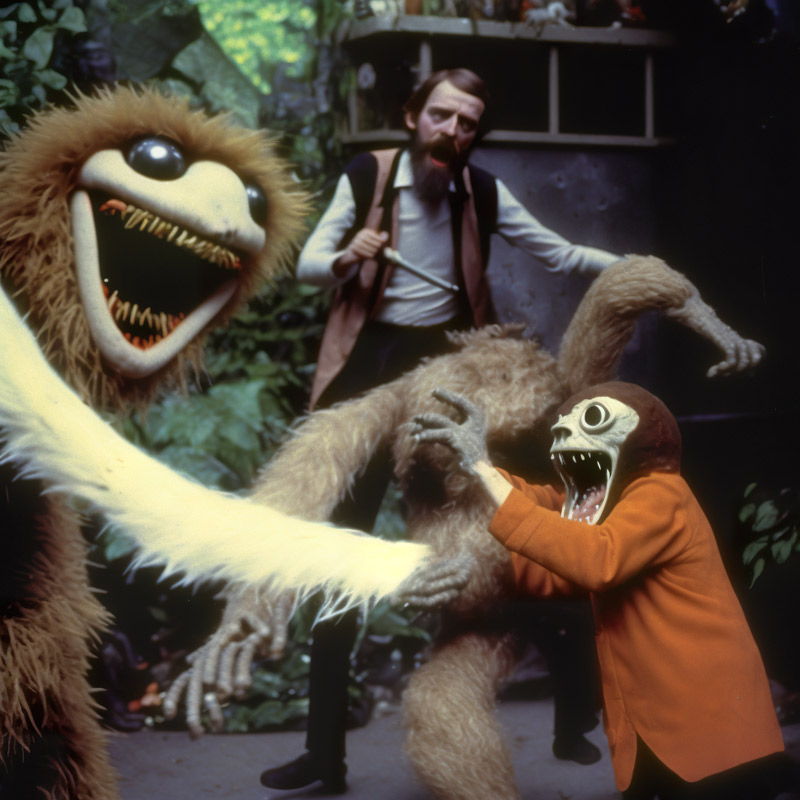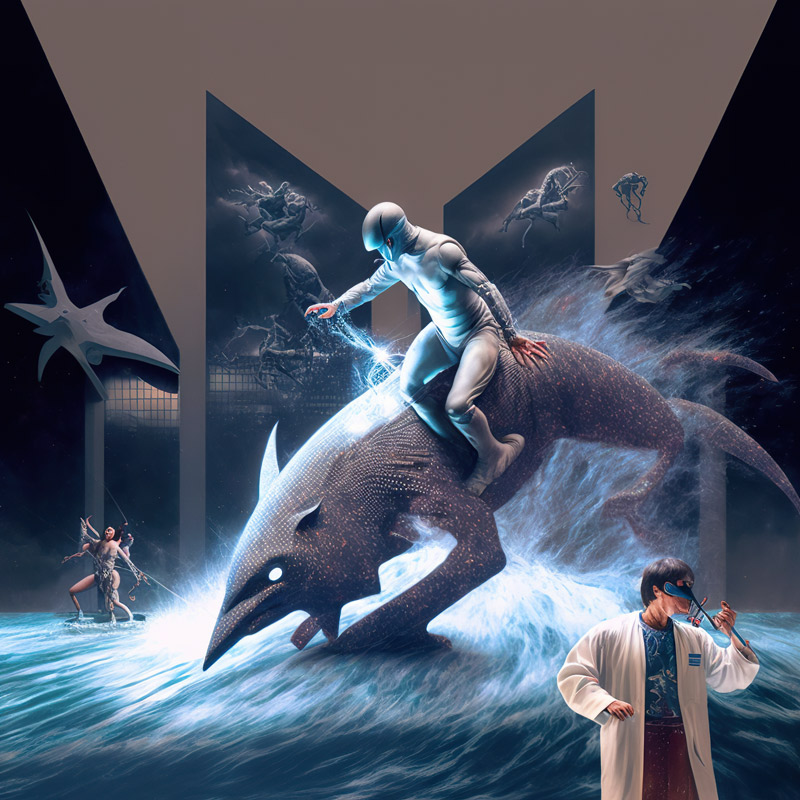Delve into a place where fantasies seem to have run amok
When I stare at Rafman’s phantasmagorical mindscapes filled with monstrous hybrids interpenetrating each other, geometrical figures, impossible buildings, knights, yuppies, scientists, intellectual mousetraps, societies out of control craving for new control systems, I think of many different things all at once, as if I could dream several dreams simultaneously. It’s a totalising panoptical turn onto the self, paranoid pandemonium where the line between good and evil is no longer clear. One could get crazy for less. If Monet’s fin de siècle paintings were a reverie for the bourgeoisie, Rafman’s depictions of virtual worlds are rapid shortcuts to hell.
Bosh would have been jealous. De Chirico too. Perhaps mostly of each other, as Rafman is bringing to Bosh what de Chirico mastered like no other – vertiginous perspectives and calm areas open for meditation – while bringing to de Chirico the thing in which Bosh excelled – crazy post-moral fantasies drenched in humour. From a philosophical point of view, one could easily claim (with the risk of being wrong of course, but what is art writing if not a highly speculative, risk-taking business) that Rafman is trying to do to art what Nietzsche did to philosophy: fucking it from the most unexpected places. Firstly, by addressing the immoral activities of the dark web and some darker parts of the porn industry with naïve, seamless Sims aesthetics. Xanax Girl, part of the DREAM JOURNAL 2016-2019 that Rafman showed at the Venice Biennale 2019 was a masterpiece in that sense, especially when we get to the scene where the young female protagonist gets “taken care of” by some hybrid cowmen she’s supposed to “milk”, to name just one of the many uncanny scenes in this tragicomic odyssey.


Rafman’s rafting on the most important shift in the symbolic order – the Internet revolution – is bewildering and highly discomforting. Fantasies seem to have run amok. Realised dreams come back to demand the best of us, making us wonder how we got here in the first place. Yet nothing else in these images seems to take place but the place. Buildings within buildings collapse or burst out of buildings. It’s like meeting a sentimental gangster that robs you of your moral and intellectual compass while at the same time leaving your pockets filled with keys to potential resolutions.
In the confessional culture of social media where everyone becomes their own surveyor, obsessed with their own consumerism, Rafman takes us “elsewhere”. How? By perverting perversion. By dismantling the very mechanisms that got us here in the first place, by depicting the highly permissive, narcissistic, pleasure oriented yet reifying and controlling metalanguage of the GAFA industries and their new opium for the people: the metaverse, which is much more controlling than Google Street View and Google Earth, which Rafman already did artworks about in 2008. “What you aspire to as revolutionaries is a master. You will get one”, said Lacan to the rebels of the ‘68 movement. Who could have guessed that the masters of our times would operate within the tech industry? The French psychoanalyst Charles Melman claimed in Les paranoïas (2014) that we’re no longer ruled by rulers, but by objects.
Rafman’s depictions of virtual worlds are rapid shortcuts to hell
No wonder Rafman’s newest imageries, recently produced for Nuda, expose a highly paranoid object oriented mass culture where the villains have lost their charisma and show us what they’ve always been: objectifying or object-oriented monsters. Some are frightening, some, like the sad monster in Extremely cursed movie still from the 90-s family, seem to be frightened by themselves, looking ready to jump into the abyss. Some monsters look as if they came from mediaeval bestiaries from the future, deprived of their usual characteristics – horns, hairy legs and gigantic claws – in favour of amorphous post-human bodies. We’re assisting once again, in a post-modern loop, the return of the real – attacking the symbolic order, again and again, becoming hyperreal. Only a catastrophe can save us now, as Slavoj Žižek famously said in a recent lecture with that very title. What catastrophe is Rafman’s world announcing? And what catastrophe could save us from that catastrophe?


Nietzsche discovered that the death of God wasn’t going to get rid of Christianity’s slave morality. As desire and machine learning theoretician Thomas Hamelryck claimed recently, technology is incapable of taking care of social media’s more nauseating aspects, for example the religious patterns of online mobs – when there is conflict, people immediately find a scapegoat and go after it. Christians were supposed to take care of victims, but these mobs are basically acting in accordance with ancient paganism in producing victims, while at the same time using Christian morality as an excuse. In Rafman’s world, this megamoral yet highly violent Internet culture is turned upside down in a monde renversé à la Rabelais. If the Rabelaisian irony criticises in order to affirm and reverses in order to correct, in Rafman’s world there is no possible redemption anymore, since (like in our dreams and the logic of the unconscious) there is no fine line between good and evil. In these monstrous places without limits, the world goes under, again and again in an unquenched desire for disaster. What is the motor of disaster? The life and death drive of the libido of course, which, as Freud discovered, is everywhere. Nothing escapes the power of this two-headed monster, which lives and thrives within us, turning the death drive inward. The result? We either become paranoid monsters or laugh at the inflation of monsters, which in itself risks creating a banalisation of monsterhood.
leaving your pockets filled with keys to potential resolutions
If the death drive is not only a limit to life, but also a tendency towards destruction essential to the living substance, we are obliged to wonder whether there is any possibility of resisting violence at all, whether we will ever come to terms with the fascism, racism and sexism within our technocratic societies. Eros is no better than the death drive. How many wars and tragedies haven’t been fought in its name? What do Eros and Thanatos need? Limits. The limit is the possibility. When we’re lost, the best thing we can do is to find a place where boundaries are clear. If that’s not enough, we can always start looking for a place that enables the desire for a new place.
That’s what seems to be Rafman’s hidden desire: A future-producing place that takes place again and again, transforming itself with the speed of light. At stake in these displaced places is not only the sublime quest for the infinite, but also the search for the limit that would both put an end to borderless jouissance and reactivate it again – since without limits, no transgressions. Even Sade knew that he needed God in order to obtain jouissance in his wicked catalogue of perversions. Where are the limits of our societies today? The limits of art? Love? Analysis? They seem to be non-existent. The only thing that controls jouissance nowadays is the attention economy that realises Hegel’s famous formula – the subject desires the desire of the other. That’s why Lacan claimed that Hegel was among the most sublime of hysterics. You either exist or don’t in the gaze of the others, but existing in their gaze is not enough, it’s a potential exposure to death, since the others can ghost you or scarify you at any time. Everyone can be dethroned, beheaded or dismembered. The only thing we can do is learn from the slaughter, from the errors – since truth arises through mistakes, and vice versa. How do we learn from errors? Where are the bullshit detectors of our world? Nowhere. And this seems to be the biggest problem, a problem that even Elon Musk has discovered recently. In a recent interview he talks about his desire to create an open AI-GPT4, where the artificial intelligence no longer lies to keep the woke community content, but actually tell “the truth” about “everything”. Thus, the paranoiac’s wildest dream will finally come true.
Hegel loved the French formula, “in pushing away the truth, one embraces it”. He knew that truth hides where we least expect it and that satire is the best way to produce revolutionary truths. In Rafman’s satirical mindscapes the abject becomes sublime, the essence of the thing itself merges with its exteriority, das Ding, the Lady, this inhuman human so much desired by the troubadours, remains unreachable, symbolised through the body of the cyborg – a pure simulacra, at the same time acting like a joke.
The limit is the possibility
Rafman, in his latest image series, even reintroduces the old time monster that used to haunt children’s nightmares: half human, half animal, half alive, half dead. Some are subjects and objects at the same time. I’m thinking of the figure in his exhibition at the Schinkel Pavillon last year where a man had merged with a toilet. In a way, one could say these hybrid, metamorphic life forms are resisting the cut, the castration – yet castrate us through their constant elusion, cutting and reactivating our desires again and again, perverting our perversions, thus refusing to become what the masochist dreams of – an object of our jouissance – because what do we do with an object that ends up satisfying us completely? Throw it in the bin.
existing in their gaze is not enough, it’s a potential exposure to death
But the bin is not the end. Rafman is junk surfing through our repressed affects, putting the bins in motion, making the undesired objects of our subculture desirable, sexy and fun again, via dream worlds that activate our psychonautic wanderlust like never before. What is art if not a journey towards the unconscious – the last dark continent not yet colonised by the GAFA industries? No wonder that the artists of our times explore it like never before, and no wonder that this exploration creates monsters, fears and paranoid belief systems that both terrify and amuse us, when reason sleeps, but also when it’s awaken – since the biggest monsters are the ones engendered by reason itself.


| Artworks | Jon Rafman |
| Words | Sinziana Ravini |
